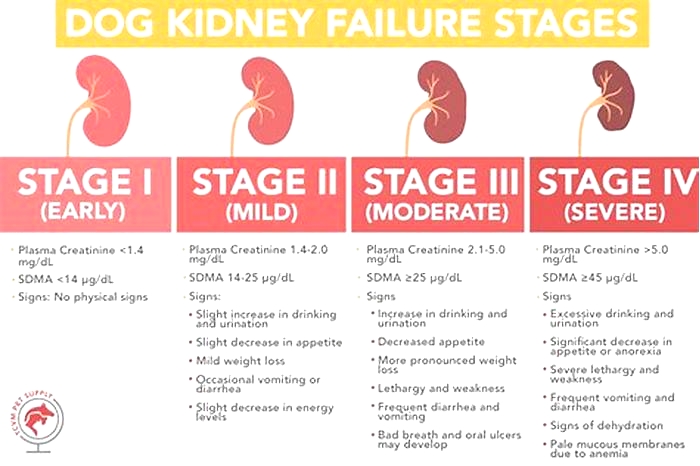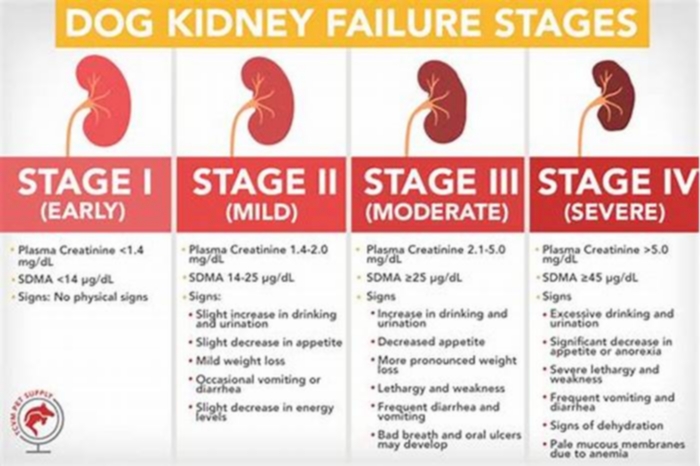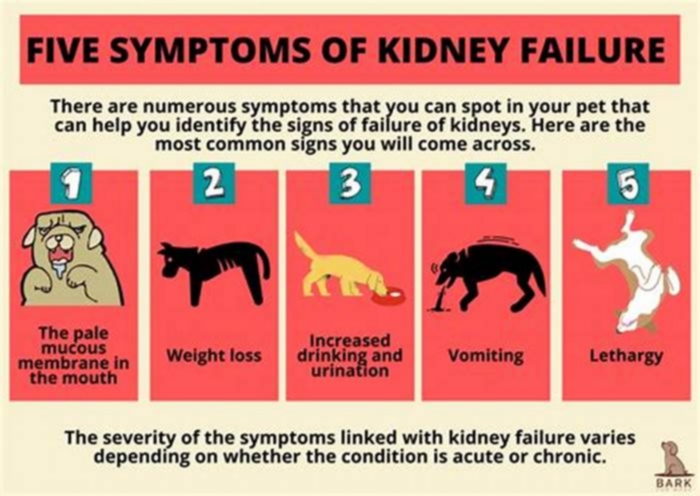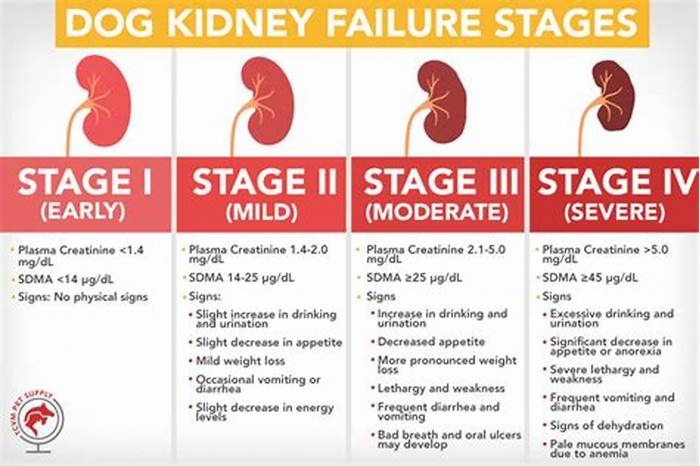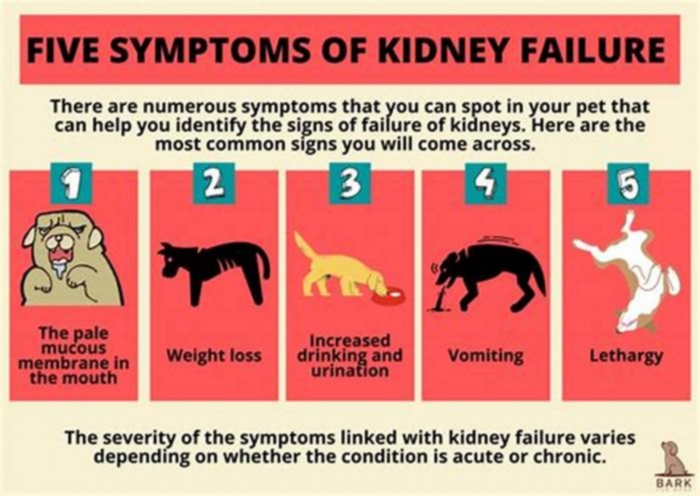signs of kidney failure for a dog
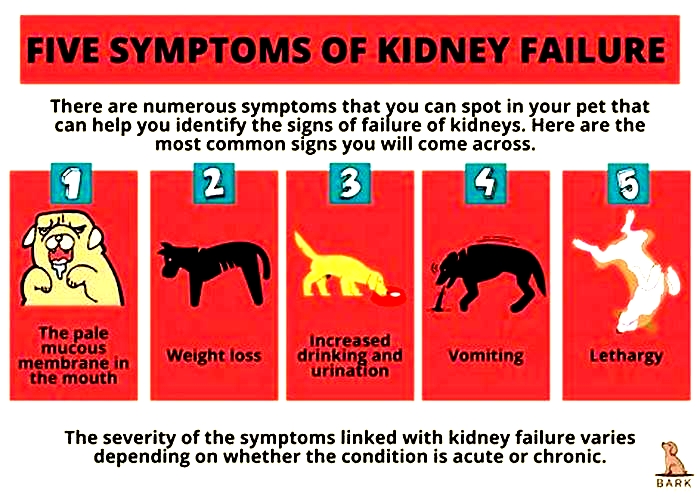
Kidney Failure In Dogs: Causes, Symptoms & Treatment Options
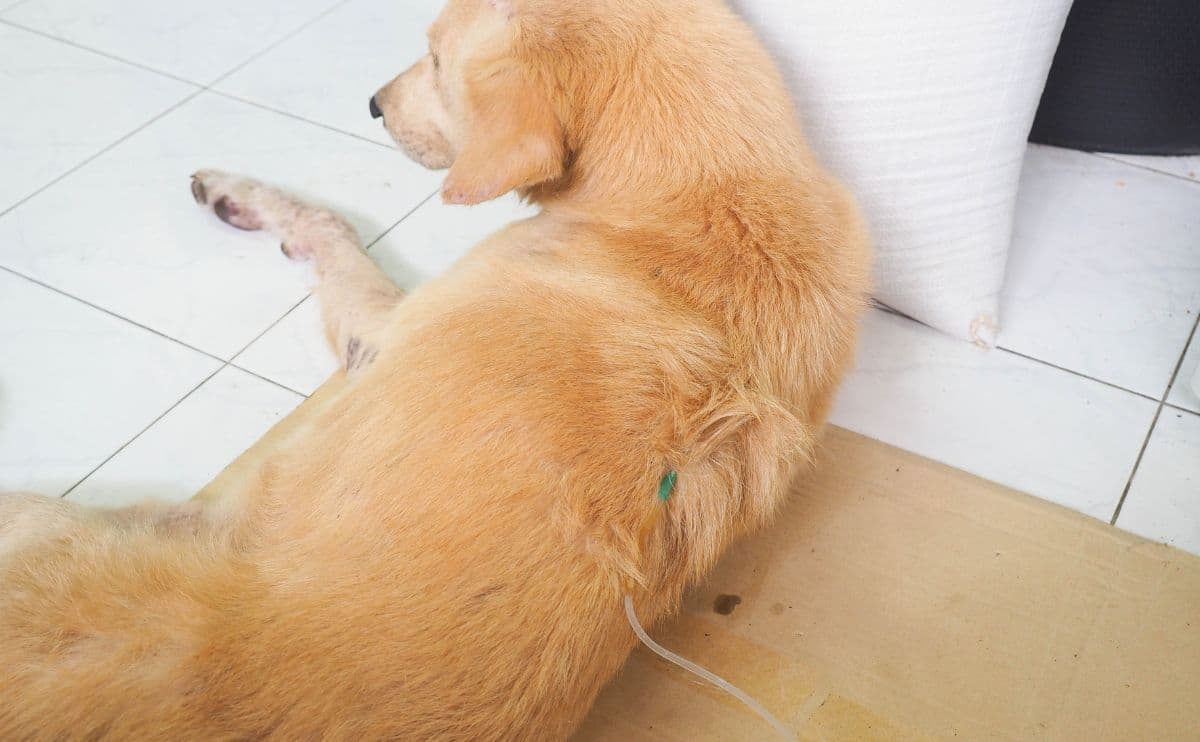
Kidney disease in dogs is a scary diagnosis for pet parents. After all, we want to spend as much time as possible with our furry family members, and the worries and concerns posed by the possibility of having to say an unexpected goodbye can take their toll. So, what is renal failure in dogs? Lets find out about the causes, the signs and symptoms, the treatment options, and how to know when its time for that final goodbye.
What Causes Kidney Failure In Dogs?
There are lots of causes of kidney failure in dogs. Toxicities from certain foods, anti-freeze, certain medications, and lilies can cause acute renal failure, even in young pets, while in some cases, the kidneys can lose their function slowly with age. Conditions like high blood pressure, cancer, bladder stones, and kidney infections can also contribute to kidney failure.
Which Foods Cause Kidney Failure In Dogs?
Grapes and raisins (and foods that contain them) can lead to kidney failure. This means that the festive period, where cookies, fruit cake, Christmas pudding, panettone, and other raisin-filled treats are everywhere, is a common time to see renal failure in dogs from toxicity.
Unfortunately, the underlying reason why grapes cause kidney damage is unknown, which means that theres no known toxic dose. Some dogs can eat grapes regularly and have no issues, while others can eat just one as a one-off with grave consequences. Therefore, its best to avoid giving your dog grapes altogether and keep them safely out of your dogs reach.
Signs Of Kidney Failure In Dogs
The signs of kidney failure in dogs are variable, depending on the stage of the disease and whether the kidney failure is acute or chronic.
Acute Kidney Failure
If your dog has acute renal failure from a toxin, obstruction, or severe infection, the symptoms are likely to come on very quickly and progress rapidly. You might notice symptoms within a couple of days of the toxicity or sooner in the case of anti-freeze. The first symptoms could be lethargy, pain, vomiting, or increased thirst. This could quickly progress to little or no urination, wobbliness, seizures, coma, or death.
Sadly, in many toxicity situations, once the kidney damage is severe enough to cause symptoms, there is far less chance of treatment being successful. Therefore, if you suspect your dog could have ingested any kind of toxin, call your veterinary clinic immediately so that appropriate measures can be taken to try to prevent any organ damage.
Chronic Kidney Failure
If your dog has chronic kidney disease, their symptoms are likely to be much more subtle and slower to develop. You might initially notice that your dog drinks more than normal or passes large volumes of urine more frequently. You might notice your pup has lost some weight, is vomiting, or hes not so interested in his food anymore. Canines with chronic kidney failure likely also seem to be subdued or lethargic.
As chronic kidney failure progresses, their thirst may become more and more excessive, but despite this, they might become dehydrated, leading to weakness and further lethargy. They may develop ulcers in their mouth, and you might notice an unpleasant smell from their mouth as the toxic waste products build up in their bloodstream. Eventually, theyll stop eating and drinking altogether, become very nauseous, and may seem painful in their abdomen.
What Causes The Symptoms Of Kidney Failure In Dogs?
The role of the kidneys within your dogs body is to control how much water leaves the body, regulate the loss of electrolytes, and remove waste products like urea from the bloodstream. In renal failure, the kidneys are no longer able to produce concentrated urine, so waste products build up in the blood. As more and more of the tiny kidney nephrons are affected, it puts more strain on the remaining parts that still work, which becomes a vicious circle.
The halitosis noted by pet owners who have dogs with chronic kidney failure is due to the build-up of these toxins and is known as a uremic smell. In some dogs, but primarily cats, small blood vessels are damaged by the urea compounds, leading to ulcers in areas like the edge of the tongue.
4 Stages Of Kidney Failure In Dogs
When it comes to the symptoms of kidney failure in dogs, stages matter. Kidney failure cases can be grouped into different stages, as formulated by the International Renal Interest Society (IRIS). The symptoms are combined with the urine concentration and blood measurements of urea, creatinine, and SDMA, which are waste products usually excreted by healthy kidneys.
In the early IRIS stages, symptoms are not apparent, whereas later, as the disease progresses, more and more symptoms appear. The IRIS stages of kidney failure in dogs illustrate the amount of kidney damage or the amount of kidney tissue that is still functional. They also aid veterinarians in determining the best treatment and management options.
Dog Kidney Failure Stages Chart
You can see the stages of chronic kidney disease in dogs in the following graphic:
| Stage | Creatinine | SDMA | Urine | Symptoms |
|---|---|---|---|---|
| I | Normal | Normal or slightly raised | May be inadequate concentration, may contain protein | None |
| II | Normal or mildly increased | Mildly raised | Inadequate concentration, may contain protein | None or very mild |
| III | Moderately increased | Moderately raised | Inadequate concentration, may contain protein | Often drinking and urinating more, may be more severe symptoms |
| IV | Markedly increased | Markedly raised | Inadequate concentration, protein likely | Weight loss, vomiting, reduced appetite, drinking and urinating more |
How To Treat Kidney Failure In Dogs
Unfortunately, when a kidney tubule (or nephron) stops working, it cant be fixed. However, treatment and good management can help to slow down the progression of kidney disease and support the remaining functional nephrons. Dogs who are still eating well and arent vomiting may only require a prescription kidney diet.
If their phosphate levels are high, a phosphate binder medication will also help by preventing the absorption of phosphate from their food. If your dog is still in the early stages of chronic kidney disease but isnt eating well or is nauseous, an anti-emetic medication may also be used.
Finally, if your dog has late stage III or stage IV kidney disease, theyll probably need to stay in the hospital for a fluid drip to flush the waste products out of the body and lower the urea and creatinine levels. Unfortunately, this improvement will only be temporary, and over time, the levels will increase once again.
When To Euthanize?
Whenever youre dealing with a chronic health issue in your dog, its really difficult to know when to make the sad decision to euthanize them. After all, theyre likely to have good and bad days, and it might feel like they get a little bit better just when you are about to make the call. The most important thing is to consider your dogs quality of life whether theyre eating, mobile, or showing any signs of pain.
If theyre struggling in more than one of those areas, despite veterinary treatment, its likely to be time to say goodbye. Its also worth looking back over the last two weeks to see how many good and bad days theyve had. If the bad days outweigh the good, euthanasia is the kindest option for your canine companion.

Frequently Asked Questions
Here are some common questions about dogs with kidney issues. Dont see yours here? Ask us in our comments.
Does pet insurance cover kidney disease in dogs?
Yes, pet insurance covers kidney disease in dogsas long as no signs or symptoms appear until after policy enrollment and waiting periods have passed.
What happens in the last days of a dog with kidney failure?
In the last days of a dog with kidney failure, theyre likely to stop eating or drinking altogether. They may be weak and wobbly from dehydration, and their other organs may start to fail. If you notice that your dog with kidney failure is deteriorating, you should contact your vet as soon as possible.
Is kidney failure in dogs painful?
Acute kidney failure, due to causes like toxins, infections, or bladder stones, can be very painful and requires emergency assessment by a veterinarian. Chronic renal failure is unlikely to be painful initially, but in the more severe stages of the disease, your dog may feel nauseous, disorientated, or painful.
What is the cost of treating kidney failure in dogs?
The cost of treating kidney failure will vary depending on your location and the type of treatment your dog needs. The most costly would be a fluid drip and hospitalization, but ongoing prescription diets and phosphate binders can also add up in the long term.
How long can a dog live with kidney failure?
The length of time that a dog can live with kidney failure will depend on the stage when the diagnosis was made. If caught early, chronic kidney failure can be managed for several years in some cases. However, if the disease is already advanced or management guidelines arent followed, a dogs quality of life may suffer within a few weeks or months.
What level of creatinine indicates kidney failure in dogs?
A dogs creatinine level should always be evaluated alongside a urine sample. If the urine sample shows poor concentration and the creatinine level is raised, this indicates that the kidneys are not functioning effectively.
Understanding Dogs Health
Kidney disease in dogs is a complex subject, and if the diagnosis is made early, even before your dog shows symptoms, the prognosis is much more favorable. Therefore, it may be a good idea to consider routine blood tests once your dog is older than seven or eight, and you should keep a close eye out for possible symptoms. You might consider an at-home urine test, that can help detect things like kidney stones and urinary tract infections in dogs.
Tagged With:What Are the Symptoms of a Dog Dying From Kidney Failure?

If your dog has been diagnosed with this renal disease or you're worried they're showing signs associated with end-stage kidney failure, a lot is probably going through your mind right now. At the forefront might be which stage of kidney disease does your dog fall under, and how can you make them as comfortable as possible? It's advisable to educate yourself about what to expect as your pet's illness progresses. That way, you can give them the best quality of life all the way through their final days.
Dog Kidney Failure Stages
Dogs with kidney failure go through a series of four stages, from diagnosis through the eventual death of the animal. These stages do not necessarily occur within rapid succession. A dog can go through them over the course of a few months or even years. Veterinarians determine the stage your dog is in by testing the urine to look for signs of the deterioration of the kidney's functions and the blood for symmetric dimethylarginine (SDMA) levels.
The Four Stages of Kidney Failure Chart
The canine kidney failure stages are determined by the levels of creatinine and SDMA, as well as the urine-to-protein (UPC) ratio and the animal's systolic blood pressure.
| Dog Kidney Failure Stage | Creatinine (in mg/dL) | SDMA (in g/dL) |
| Stage 1 | less than 1.4 | less than 18 |
| Stage 2 | 1.4 to 2.0 | 18 to 35 |
| Stage 3 | 2.1 to 5.0 | 36 to 54 |
| Stage 4 | greater than 5.0 | greater than 54 |
Other clinical indications that a dog is in the stages of kidney failure are:
- UPC Ratio:
- Nonproteinuric: less than 0.2
- Borderline proteinuric: 0.2 to 0.5
- Proteinuric: greater than 0.5
- Systolic blood pressure (in mmHg):
- Normotensive: less than 150
- Borderline hypertensive: 150 to 159
- Hypertensive: 160 to 179
- Severely hypertensive: greater than 180
Symptoms of End-Stage Kidney Failure in Dogs
The most common signs a dog is dying from kidney failure include:
- Uremia: The buildup of waste products in the body produces a distinctive ammonia smell that is especially apparent on the breath.
- Pale, dry gums: The gums are duller and dry to the touch.
- Mouth ulcers: Uremia causes raw mouth ulcers that are painful.
- Bloodshot eyes: The whites of the eyes are bloodshot.
- Increased thirst: An affected dog drinks water excessively.
- Increased urination: The dog will urine large volumes of dilute urine.
- Dehydration: Despite more fluid intake, the dog is dehydrated.
- Decreased appetite: The dog loses interest in food.
- Weight loss: The dog steadily loses weight.
- Gradual loss of fat and muscle mass: The weight loss affects both fat and muscle mass and can cause emaciation.
- Dull coat that sheds excessively: The lackluster coat constantly sheds and looks unkempt.
- Lethargy: The dog has little energy or interest in moving around.
- Fatigue: The dog sleeps most of the day and night with only brief periods of wakefulness.
- Vomiting: The dog vomits frequently and cannot keep food down.
- Anemia: The dog may develop anemia.
- High blood pressure: The dog has elevated blood pressure.
- Incontinence: A dog cannot control their urination.
- Difficulty breathing: The dog has problems breathing normally.
- Slowing heart rate: A faster heart rate is generally present with kidney failure, but the heart rate begins to slow down during the end stage of the disease.
- Depression: The dog seems sad and does not respond to any of their favorite things.
- Low temperature: Dogs in their last days of kidney failure can experience hypothermia or a low body temperature.
- Lack of interest in surroundings: The dog is unaware of or disinterested in their surroundings.
- Disorientation: The dog acts confused at times.
- Loss of balance and coordination: The dog appears clumsy and unsteady on their feet.
- Trembling or shaking: The dog has tremors or episodes of shaking.
- Seizures: The dog suffers periodic seizures, one of the major signs of end-stage kidney failure.
Keeping Your Pet Comfortable
Watching your pet go through this can be very difficult. However, there are things you can do to help keep your dog comfortable during the final stages of kidney disease.
- Spend as much time as possible with your dog. Even being in the same room will be soothing to them.
- Make sure your dog's resting area is quiet, warm, and cozy. Provide them with their favorite blanket and toy.
- Protect your pet from other pets or people who may be too rough with them. Supervise interactions with children and teach them to be gentle with the dog.
- Pet your dog and talk to them frequently.
- Change your dog's bedding often and keep them clean and dry. Brush their fur for dry cleaning. Clean their fur with a sponge bath solution of hypoallergenic pet shampoo.
- Feed your pet a low-protein dog food appropriate for a kidney failure diet.
- If your dog refuses to eat or has trouble eating, ask the veterinarian about other feeding options such as an esophagostomy tube to keep them nourished.
- Monitor your dog's temperature and keep them warm with plenty of cozy blankets.

Last Days of a Dog Dying From Kidney Failure
While a dog owner may fear that entering the final stage of kidney failure means their dog's passing away is imminent, it is difficult to predict how long the does has left. In general, you can expect your dog to pass away within three months of moving into stage 4, though some dogs may thrive for up to a year.
It depends on the associated symptoms and other conditions that may arise due to the dog's poor health. Your dog's age is another factor. There's a lot to keep in mind, a lot to hope for, and the reality that you're facing the end of your dog's life.
Fast Fact
Controlling your dog's diet can help during their struggle with renal failure. Carefully discuss nutrition with your dog's veterinarian.
When to Consider Euthanization
When a dog enters end-stage renal failure, your veterinarian may recommend an end-of-life home treatment plan or a hospice program to make your pet's last days comfortable and maintain your pet's quality of life. For end-stage kidney failure, a treatment plan may include dialysis, a stomach tube, intravenous therapy, pain medication, and methods to care for an incontinent pet.
Depending on their symptoms, your dog may not necessarily be in severe pain, but they will be uncomfortable at the least from other symptoms, including frequent vomiting and diarrhea, lethargy and depression, and constant dehydration. Your veterinarian may recommend euthanasia if a dog is suffering, unresponsive to pain management, or too weak to handle necessary life-sustaining treatment.
Dealing With the Loss
It's hard to come to terms with the fact that a pet is dying. Find comfort in the fact that your dog appreciates your loving care in their final days. They know you love them and take comfort in your presence and all that you do to make their life easier.
2024 LoveToKnow Media. All rights reserved.


